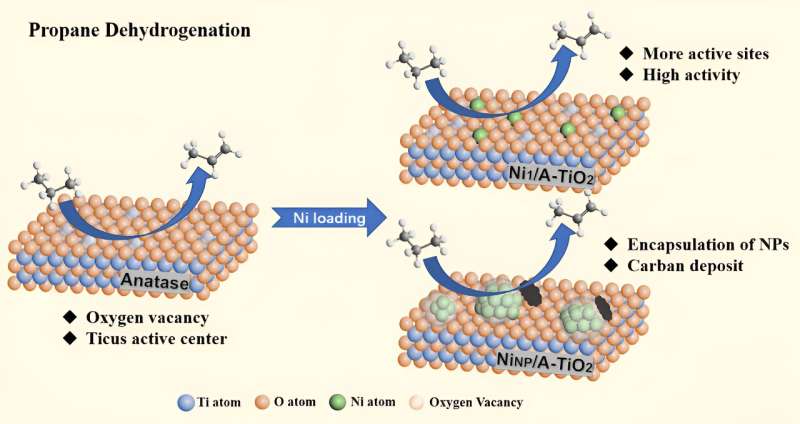This article has been reviewed according to Science X's editorial process and policies. Editors have highlighted the following attributes while ensuring the content's credibility:
fact-checked
trusted source
proofread
Research demonstrates anatase supported Ni single-atom catalysts for propane dehydrogenation

Propylene is one of the most important petrochemical raw materials, ranging second after ethylene. To meet the ever-increasing demand, alternative technologies for propylene production are in urgent need, among which the propane dehydrogenation (PDH) has been considered as the most promising one.
As a cheap and environmentally friendly candidate, Ni-based catalysts have attracted wide interest of researchers in various catalytic applications, such as hydrogenation, reforming of methane, electrochemical and photocatalytic, etc. However, there has been little study of Ni in alkane dehydrogenation under high temperatures, likely because Ni species are easily reduced to metal Ni nanoparticles (NPs) during the harsh reaction, which may result in deep dehydrogenation and poor selectivity.
As a new frontier in the field of catalysis, single-atom catalysts (SAC) have been widely used in various catalytic reactions, but their application in the dehydrogenation of light hydrocarbons at high temperatures has been limited. In propane dehydrogenation, C-H bond activation is insensitive to the catalyst structure, but undesired side reactions such as hydrolysis, isomerization, and coking are typical structure-sensitive reactions that require the participation of multiple metal atoms.
Therefore, SACs with isolated dispersed metal active centers have obvious advantages in suppressing these side reactions and become potential candidates for catalytic dehydrogenation of alkanes.
Recently, a research team led by Prof. Botao Qiao from Dalian Institute of Chemical Physics, Chinese Academy of Sciences, demonstrated that anatase TiO2 supported Ni single-atom catalyst (Ni1/A-TiO2) exhibited not only superior intrinsic activity and propylene selectivity but also much better stability than the corresponding Ni nanoparticle (NP) catalyst (NiNP/A-TiO2) in PDH reaction at 580 °C.
The rate of propylene production on Ni1/A-TiO2 was about 1.96 molC3H6·gNi-1·h-1, above 65 times than that of NiNP/A-TiO2 sample (0.03 molC3H6·gNi-1·h-1).
In combination with HAADT-STEM, in-situ CO-DRIFTS, in-situ XPS, and XAS characterizations, they confirmed that the Ni SAC mainly contains individual Ni atoms singly dispersed on the support in positive Ni (II) valence state, with mainly played as active center rather than promoted the formation of coordinated unsaturated Ti ion sites.
In addition, as a result of strong metal-support interaction between Ni NPs and TiO2 carrier during reduced conditions, the Ni nanoparticles sites were encapsulated by TiOx overlayer (~2 nm thick) thus displayed lower initial propane conversion and lower durability. This work highlights the advantage of the single-atom catalyst with an isolated active site in PDH reaction and provides a reference for future research on the preparation and application of SACs.
The findings are published in the Chinese Journal of Catalysis.
More information: Qian Zhang et al, Catalytic propane dehydrogenation by anatase supported Ni single-atom catalysts, Chinese Journal of Catalysis (2024). DOI: 10.1016/S1872-2067(23)64584-X
Provided by Chinese Academy of Sciences





















